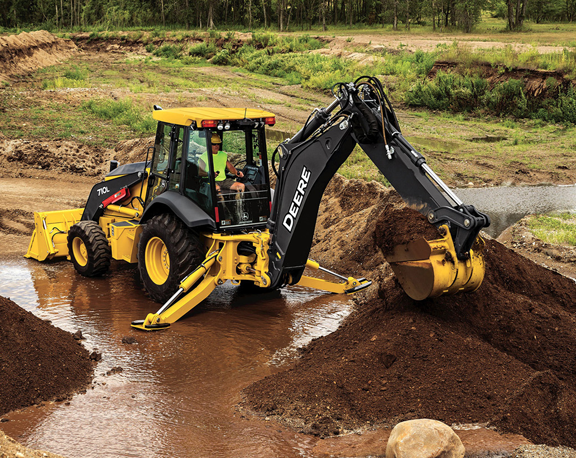Deere Introduces 148 HP Backhoe, Largest In Its Line
John Deere has added the 710L backhoe loader to its line. The new Tier 4 final machine uses a 4.5L 148 hp Deere PowerTech Plus engine and offers a 17-foot 3-inch dig depth, the largest in the John Deere portfolio.
 The new backhoe ofers additional lift capability and an improved rear control valve for enanched controllability, said Brian Hennings, product marketing manager, backhoes and tractor loaders, John Deere Construction & Forestry. The 710L include a standard John Deere PowerShift transmission that enables operators to travel up to 23 mph between job sites. Using the sealed-switch module (SSM), operators can get an additional 10 percent craning boost through the Lift Mode feature; when selected, engine rpm is automatically set at 1,400, and the machine maximizes hydraulic pressure for increased craning capability.
The new backhoe ofers additional lift capability and an improved rear control valve for enanched controllability, said Brian Hennings, product marketing manager, backhoes and tractor loaders, John Deere Construction & Forestry. The 710L include a standard John Deere PowerShift transmission that enables operators to travel up to 23 mph between job sites. Using the sealed-switch module (SSM), operators can get an additional 10 percent craning boost through the Lift Mode feature; when selected, engine rpm is automatically set at 1,400, and the machine maximizes hydraulic pressure for increased craning capability.
Pressure-compensated load-sensing (PCLS) hydraulics ensure multifunction operation. Ride control enables front loader hydraulic cylinders to act as shock absorbers, smoothing travel over rough terrain.
The new cab offers extra legroom and a more comfortable seat, redesigned pilot towers with fingertip electrohydraulic (EH) controls, a multifunction lever on the steering column to control turn signals, wipers and lights, and a state-of-the-art multi-language monitor. Operators can program time-specific functions, such as auto shutdown and auto idle.
Other enhanced 710L backhoe creature comforts include an efficient heating, ventilation and air conditioning (HVAC) system, adjustable mechanical or air-suspension seat, a new lighting scheme with an optional light-emitting diode (LED) lighting kit to enhance visibility to extend the workday and an elevated canopy to provide better visibility for both the front and rear of the backhoe.
When activated, the Economy mode feature limits maximum engine rpm in loader and backhoe operations. A variable-speed, electronically-controlled fan automatically speeds up or slows down, operating only as needed to keep things cool, helping conserve power and fuel while reducing noise.
Same-side ground-level service points help speed daily checks. Other common-sense features, such as extended service intervals, simple-to-read sight gauges and easy-access grease points, help increase uptime and lower daily operating costs.










